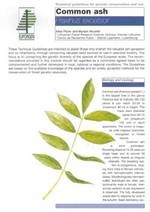Fraxinus excelsior - Technical guidelines for genetic conservation and use for common ash
This publication has been translated into the following languages:
Slovenian Italian Polish
Genetic conservation aims at ensuring continuous survival and adaptability of the target species. These objectives are met when the Multiple Population Breeding System (MPBS) is applied. Ideally in MPBS, a breeding population is subdivided into subpopulations which are then grown over a wide range of site conditions.
In each country where common ash is found, an inventory should be undertaken to define the geographical distribution of the species, conservation status, threats and potential use patterns. Ecogeographic zones (provenance regions) should be delimited according to climatic variation, topography, soil and vegetation. Trees are generally best adapted to the ecological conditions of the region where they evolved. Therefore, local material should be used for plantations wherever possible, unless otherwise recommended as the result of data from provenance trials.
To ensure the adaptive potential of Fraxinus excelsior in Europe, it is recommended that two complementary gene conservation networks of populations are established, specifically: (1) a network of 20-30 in situ populations throughout provenance regions; and (2) a network of ex situ populations (progeny trials, provenance trials, collections). Whenever possible, in situ conservation activities should be undertaken jointly for other Noble Hardwoods.
Where common ash occurs in large populations in a country, in situ conservation is sufficient, with the selection of up to three gene conservation populations/ gene reserves of 5-15 ha in size, with at least 100 flowering trees in each provenance. A high density of in situ gene conservation populations should be established in Southeast Europe, especially in Romania and Bulgaria, which have been colonised by populations from different ice age refuges. In these regions, neutral genetic markers show high differentiation among populations, suggesting that they may have different potentials to cope with future climatic conditions. Specific conservation efforts are also recommended in northern central Europe, due to the high level of differentiation between populations in southern Sweden, although the historical origin of this differentiation still needs to be verified.
In situ gene conservation populations need to be managed to increase their adaptive potential by ensuring the natural regeneration of the target species, creating multi-age structure and habitat diversity, and increasing generation turnover.
To conserve an even-aged mature stand in situ, parts of the population should be opened (thinned or cut in narrow strips of 15-30 m width) to create conditions for natural regeneration. Preferably, this should be undertaken in the year following the mast, when maximum seed is produced by the stand. An area adjacent to the gene reserve could be set aside for natural regeneration, and could later be incorporated as part of the reserve.
To promote regeneration in clear-cut strips, randomly selected, abundantly flowering seed trees should be left. If the population consists of some stands or groups of trees of different ages but there is no regeneration, the oldest stands or groups should be cut as soon as the mast years have produced sufficient seed yield or regeneration under the canopy or in areas set aside. Increasing the number of stands or demes (groups of trees) of different ages in the population enhances intra-population genetic variation as the portion of trees involved in regeneration increases. Regeneration can also be stimulated by site scarification and weed control. If these regeneration support measures are not successful, it is recommended that material originating from the population is planted: seed should be collected from at least 50 trees per population, preferably from central parts of the gene reserve. To prevent gene flow from outside the gene reserve, a buffer zone of 100- 150 m should be created by gradually removing mature flowering ash trees within this zone.
To secure the sustainability of each population, careful tending is required. Effective treatment including adequate silvicultural measures, protection against disease or insect outbreaks, fire or other factors must be undertaken promptly. Thinning should be undertaken from below, removing suppressed and injured trees, thus simulating and stimulating the natural selection processes in the forest, and stand regeneration. Each gene conservation population must be constantly monitored, including the health status and regeneration success.
For populations that are marginal, isolated, endangered, growing under special ecological conditions or carrying rare features, in situ conservation should be complemented by ex situ measures. The most effective form is through progeny trials, which permits joint gene conservation and breeding. On a national scale, 1-3 progeny plantations for conservation/breeding (each of 2-4 ha in size) should be established in each provenance region with entries sampled from single trees randomly chosen from 10- 20 stands within the region and from marginal populations if applicable. As soon as reproductive age is reached, open pollination of the best individuals selected within each family should ensure the next generation. About 50 optimally adapted individuals should be the founders of each new gene conservation/ breeding sub-population
Authors: Alfas Pliûra; Myriam Heuertz
Corporate Author: European Forest Genetic Resources Programme; International Plant Genetic Resources Instit., Rome (Italy)
Journal/Series:
EUFORGEN Technical Guidelines for Genetic Conservation and Use
Publication Year: 2003
Publication Format: Folder; PDF
ISBN: 92-9043-567-4
ISBN 13: 978-92-9043-567-9
Language: EN
Pages: 6 p.
Technical guidelines Fraxinus excelsior

